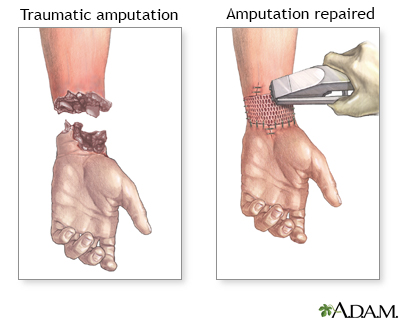Pregnancy SmartSiteTM
Loss of a body part DefinitionTraumatic amputation is the loss of a body part, usually a finger, toe, arm, or leg, that occurs as the result of an accident or injury. ConsiderationsIf an accident or trauma results in complete amputation (the body part is totally severed), the part sometimes can be reattached, often when proper care is taken of the severed part and stump, or residual limb. In a partial amputation, some soft-tissue connection remains. Depending on how severe the injury is, the partially severed extremity may or may not be able to be reattached. Complications often occur when a body part is amputated. The most important of these are bleeding, shock, and infection. Long-term outcome for an amputee depends on early emergency and critical care management. A well-fitting and functional prosthesis and retraining can speed rehabilitation. CausesTraumatic amputations usually result from factory, farm, power tool accidents, or from motor vehicle accidents. Natural disasters, war, and terrorist attacks can also cause traumatic amputations. SymptomsSymptoms may include:
First AidSteps to take:
Do Not
When to Contact a Medical ProfessionalIf someone severs a limb, finger, toe, or other body part, you should call right away for emergency medical help. PreventionUse safety equipment when using factory, farm, or power tools. Wear seat belts when driving a motor vehicle. Always use good judgment and observe appropriate safety precautions. ReferencesAmerican Academy of Orthopaedic Surgeons website. Fingertip injuries and amputations. orthoinfo.aaos.org/en/diseases--conditions/fingertip-injuries-and-amputations. Reviewed May 2022. Accessed November 21, 2022. Rose E. Management of amputations. In: Roberts JR, Custalow CB, Thomsen TW, eds. Roberts & Hedges' Clinical Procedures in Emergency Medicine and Acute Care. 7th ed. Philadelphia, PA: Elsevier; 2019:chap 47. Switzer JA, Bovard RS, Quinn RH. Wilderness orthopedics. In: Auerbach PS, Cushing TA, Harris NS, eds. Auerbach's Wilderness Medicine. 7th ed. Philadelphia, PA: Elsevier; 2017:chap 22. | |
| |
Review Date: 9/20/2022 Reviewed By: C. Benjamin Ma, MD, Professor, Chief, Sports Medicine and Shoulder Service, UCSF Department of Orthopaedic Surgery, San Francisco, CA. Also reviewed by David C. Dugdale, MD, Medical Director, Brenda Conaway, Editorial Director, and the A.D.A.M. Editorial team. The information provided herein should not be used during any medical emergency or for the diagnosis or treatment of any medical condition. A licensed medical professional should be consulted for diagnosis and treatment of any and all medical conditions. Links to other sites are provided for information only -- they do not constitute endorsements of those other sites. No warranty of any kind, either expressed or implied, is made as to the accuracy, reliability, timeliness, or correctness of any translations made by a third-party service of the information provided herein into any other language. © 1997- A.D.A.M., a business unit of Ebix, Inc. Any duplication or distribution of the information contained herein is strictly prohibited. | |

 Amputation repair
Amputation repair
